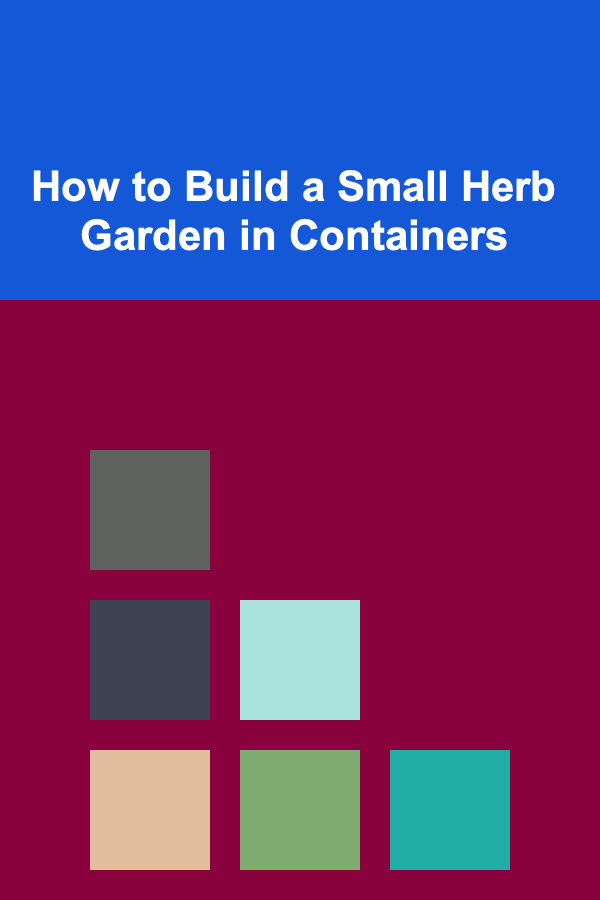
How to Build a Small Herb Garden in Containers
ebook include PDF & Audio bundle (Micro Guide)
$12.99$8.99
Limited Time Offer! Order within the next:

Building a small herb garden in containers is an incredibly rewarding and accessible way to grow fresh herbs, whether you're a beginner or an experienced gardener. It's perfect for people who may not have a traditional garden space or those who live in apartments or homes with limited outdoor areas. Container gardening allows you to cultivate a variety of herbs on your balcony, patio, windowsill, or even indoors, all while maintaining easy access to fresh, homegrown ingredients for cooking, teas, and natural remedies.
This guide will walk you through the entire process of creating a thriving container herb garden. From selecting the right containers and herbs to proper care and harvesting techniques, we'll cover all the essential steps to help you succeed.
Why Choose Container Gardening for Herbs?
Container gardening offers several advantages, especially for herb gardening. Here are some reasons why you might want to grow herbs in containers:
1. Flexibility of Location
With containers, you can place your herbs anywhere you want, as long as they receive enough sunlight. Whether it's on a sunny balcony, a kitchen windowsill, or a shady porch, container gardening offers flexibility in choosing the ideal location for your plants.
2. Portability
Container gardens are portable. If a plant isn't thriving in one location, you can easily move it to a different spot with more sunlight or protection from wind. This also allows you to move your garden indoors if the weather is unfavorable.
3. Less Strain on Space
For people who live in small apartments or homes with limited outdoor space, container gardening provides an efficient way to grow herbs without needing a full-fledged garden. Even a small balcony, patio, or countertop is sufficient for cultivating an herb garden.
4. Easier Maintenance
Containers allow for better control over the soil quality, water drainage, and plant spacing. It's easier to manage the garden and make adjustments to the environment. You can also use high-quality, sterile potting mix, reducing the likelihood of pests or diseases.
5. Aesthetic Appeal
Herbs can add visual appeal to your home or outdoor space. With different colors, textures, and heights, they can enhance the aesthetic of your environment while providing you with fresh ingredients for your meals.
Steps to Build Your Herb Garden in Containers
1. Choose the Right Containers
The first step in building your herb garden is selecting appropriate containers. The right containers are essential for ensuring that your herbs have the space they need to thrive.
1.1 Size of Containers
When selecting containers, make sure they are large enough to accommodate the root systems of the herbs you want to grow. While herbs like basil and parsley require pots that are at least 6 to 8 inches deep, larger herbs such as rosemary and thyme may require deeper containers, closer to 12 inches or more.
You can use individual pots for each herb, or you can use larger containers to plant multiple herbs together. Be sure that the container has enough space for each plant to grow without overcrowding.
1.2 Drainage
Proper drainage is critical for the health of your herbs. Without drainage holes, water can accumulate at the bottom of the container, leading to root rot. Most plant pots are designed with drainage holes, but if you're using a container that doesn't have them, you can create drainage by drilling holes in the bottom.
In addition to drainage, you can add a layer of gravel or small stones at the bottom of the pot before filling it with soil. This will help prevent the drainage holes from becoming clogged.
1.3 Material of Containers
The material of the container can affect water retention, temperature regulation, and durability. Common materials include:
- Plastic: Lightweight, inexpensive, and retains moisture well.
- Terracotta: Porous and breathable but can dry out quickly in hot weather.
- Ceramic: Decorative and durable, though they can be heavy.
- Wood: A natural and aesthetically pleasing option, though it may rot over time if not treated.
Choose containers based on your personal style and the environmental conditions in which you will be growing the herbs.
2. Select the Right Herbs for Container Gardening
When selecting herbs for your container garden, consider both the growing conditions (sunlight, temperature, and moisture) and the types of herbs that are well-suited to container growth. Here are some popular herbs that thrive in containers:
2.1 Basil
Basil is a popular herb known for its fragrant leaves and use in a variety of dishes. It thrives in warm conditions and requires full sunlight, making it perfect for container gardening.
2.2 Mint
Mint grows well in containers due to its tendency to spread aggressively. A container will help prevent it from taking over your garden. Mint prefers part-sun to full-sun and regular watering.
2.3 Parsley
Parsley is a hardy herb that can grow well in containers. It enjoys full sun but can tolerate some shade. Parsley is also an excellent herb to grow indoors, making it versatile for various growing environments.
2.4 Thyme
Thyme is a low-maintenance herb that thrives in full sun and well-draining soil. It is drought-tolerant and doesn't require frequent watering, making it ideal for containers.
2.5 Rosemary
Rosemary is a hardy, aromatic herb that thrives in warm conditions and needs plenty of sunlight. It does well in larger containers and, like thyme, prefers drier conditions.
2.6 Chives
Chives are another great choice for container gardening. They're easy to grow, require minimal maintenance, and enjoy full sun. Chives are excellent for cooking and can be harvested throughout the growing season.
3. Prepare the Soil
Herbs require well-draining soil to thrive. Choose a good quality potting mix designed for container gardening. Avoid using garden soil in containers, as it can become compacted and restrict root growth. You can mix in compost or other organic matter to enrich the soil.
To ensure proper drainage, add a layer of gravel or small stones at the bottom of the container, followed by your potting mix. This helps keep the roots from sitting in water and promotes healthy growth.
4. Planting the Herbs
4.1 Spacing
When planting multiple herbs in a single container, make sure to leave enough space between each plant for proper air circulation. Overcrowding can lead to competition for nutrients, sunlight, and water. Generally, space herbs 6 to 12 inches apart, depending on the variety and container size.
4.2 Planting Depth
Plant herbs at the same depth they were growing in their nursery containers. Gently remove the herbs from their pots, loosen the roots if they are root-bound, and plant them in the new container, ensuring that the top of the root ball is level with the soil surface.
4.3 Watering After Planting
Once your herbs are planted, water them thoroughly to settle the soil around the roots. Ensure the water drains freely from the container, as this will help prevent waterlogging.
5. Care and Maintenance of Your Herb Garden
5.1 Watering
Herbs in containers generally need more frequent watering than those in the ground, as the soil in pots dries out faster. Water your plants when the top inch of the soil feels dry to the touch. Be careful not to overwater, as too much moisture can lead to root rot. Always allow excess water to drain from the container.
5.2 Fertilizing
Herbs don't require heavy feeding, but you can fertilize them occasionally to encourage strong growth. Use a balanced, slow-release fertilizer or an organic liquid fertilizer once a month during the growing season.
5.3 Pruning and Harvesting
Pruning is essential to keep your herbs healthy and productive. Regularly trim back any dead or diseased leaves and encourage new growth by cutting the tips of the stems. Harvest herbs by cutting leaves or sprigs as needed, but avoid removing more than one-third of the plant at once to ensure it continues to grow well.
6. Managing Pests and Problems
Herbs in containers are not immune to pests, though they are often less susceptible than plants in the ground. Keep an eye out for aphids, spider mites, and whiteflies. Use natural pest control methods, such as spraying plants with insecticidal soap or introducing beneficial insects like ladybugs.
Additionally, if your herbs are not growing well, check for common issues such as poor drainage, overwatering, or insufficient sunlight.
Conclusion
Building a small herb garden in containers is an excellent way to enjoy fresh, flavorful herbs right at your fingertips. With the right containers, quality soil, and proper care, you can cultivate a thriving herb garden in any space---whether it's a sunny windowsill or a small patio. By following the steps outlined in this guide, you'll have the satisfaction of harvesting your own homegrown herbs while enjoying the numerous culinary, health, and aesthetic benefits they provide.
Happy gardening!
Reading More From Our Other Websites
- [Home Maintenance 101] How to Detect and Fix Plumbing Leaks Before They Worsen
- [Home Pet Care 101] How to Recognize Signs of Illness in Your Pet
- [Organization Tip 101] How to Create a Comfortable Atmosphere for Reading
- [Home Security 101] How to Prevent Identity Theft with Home Security Measures
- [Hiking with Kids Tip 101] Safety First: Managing Slippery Paths and Warmth When Hiking with Kids in the Rain
- [Organization Tip 101] How to Use Storage Ottomans for Hidden Organization
- [Home Budget 101] How to Create an Effective Debt Repayment Plan for Your Home Budget
- [Home Budget Decorating 101] How to Decorate Your Home for Spring Without Spending Much
- [Home Budget 101] How to Set Up Sinking Funds Explained: A Step‑By‑Step Guide
- [Rock Climbing Tip 101] How to Optimize Your Climbing Shoes for Tight Cracks in Sandstone Formations

How to Choose the Best Air Conditioner for Your Space
Read More
How to Light Your Home Office for Maximum Productivity
Read More
How to Set Up a Checklist for Engaging Your Audience During a Presentation
Read More
Smart Strategies for Cutting Down on Fast Food Expenses Without Sacrificing Convenience
Read More
The E-commerce Manager's Playbook: Optimizing Platforms for Maximum Conversion
Read More
How to Navigate Dating Across Cultures
Read MoreOther Products

How to Choose the Best Air Conditioner for Your Space
Read More
How to Light Your Home Office for Maximum Productivity
Read More
How to Set Up a Checklist for Engaging Your Audience During a Presentation
Read More
Smart Strategies for Cutting Down on Fast Food Expenses Without Sacrificing Convenience
Read More
The E-commerce Manager's Playbook: Optimizing Platforms for Maximum Conversion
Read More